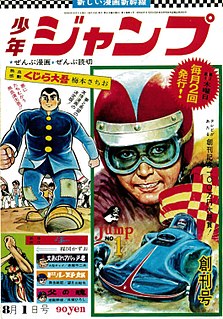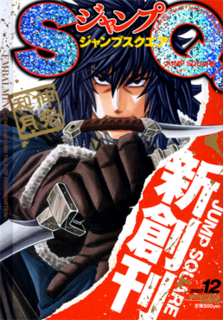This article needs additional citations for verification .(April 2018) (Learn how and when to remove this template message) |
This is a summary list of magazine lists.
This article needs additional citations for verification .(April 2018) (Learn how and when to remove this template message) |
This is a summary list of magazine lists.
| This article includes a mass media-related list of lists. |

Manga are comics or graphic novels originating from Japan. Most manga conform to a style developed in Japan in the late 19th century, though the art form has a long prehistory in earlier Japanese art. The term manga is used in Japan to refer to both comics and cartooning. Outside Japan, the word is typically used to refer to comics originally published in the country.

Shōnen, shonen, or shounenmanga is manga aimed at a young teen male target-demographic. The age group varies with individual readers and different magazines, but it is primarily intended for boys between the ages of 12 and 18. The kanji characters (少年) literally mean "boy" or "youth", and the characters (漫画) means "comic". Thus, the complete phrase means "young person's comic", or simply "boys' comic"; its female equivalent is shōjo manga. Shōnen manga is the most popular and best-selling form of manga.

Comics is a medium used to express narratives or other ideas through images, usually combined with text. It typically takes the form of a sequence of panels of images. Textual devices such as speech balloons, captions, and onomatopoeia can indicate dialogue, narration, sound effects, or other information. The size and arrangement of panels contribute to narrative pacing. Cartooning and other forms of illustration are the most common image-making means in comics; fumetti is a form which uses photographic images. Common forms include comic strips, editorial and gag cartoons, and comic books. Since the late 20th century, bound volumes such as graphic novels, comic albums, and tankōbon have become increasingly common, while online webcomics have proliferated in the 21st century.

Seinen manga (青年漫画) are manga marketed toward young adult men. In Japanese, the word seinen literally means "youth", but the term "seinen manga" is also used to describe the target audience of comics like Weekly Manga Times and Weekly Manga Goraku which are aimed at men from their late teens to their 30s. Seinen manga are distinguished from shōnen manga which are for younger teen boys, although some seinen manga like xxxHolic share similarities with shōnen manga. Seinen manga can focus on action, politics, science fiction, fantasy, relationships, sports, or comedy. The female equivalent to seinen manga is josei manga.

Josei manga are Japanese comics aimed at older teenage girls and adult women who are able to read kanji without the aid of furigana. Josei manga should not be confused with shōjo manga (少女漫画), aimed at younger teenage girls, or "ladies' comics", also known as "LadyComi", which tend to contain erotic content and only takes up a portion of josei rather than its entirety. Readers can range in age from 18 to 45. Josei is the Japanese word for "woman".

Weekly Shōnen Jump is a weekly shōnen manga anthology published in Japan by Shueisha under the Jump line of magazines. It is the best-selling manga magazine, as well as one of the longest-running; the first issue was released with a cover date of August 1, 1968. The manga series within the magazine target young male readers and tend to consist of many action scenes and a fair amount of comedy. The chapters of series that run in Weekly Shōnen Jump are collected and published in tankōbon volumes under the "Jump Comics" imprint every two to three months.

Shojo Beat is a shōjo manga magazine formerly published in North America by Viz Media. Launched in June 2005 as a sister magazine for Shonen Jump, it featured serialized chapters from six manga series, as well as articles on Japanese culture, manga, anime, fashion and beauty. After its initial launch, Shojo Beat underwent two redesigns, becoming the first English anthology to use the cyan and magenta ink tones common to Japanese manga anthologies. Viz launched a related imprint of the same name for female-oriented manga, light novels and anime.

An original English-language manga or OEL manga is a comic book or graphic novel drawn in the style of manga and originally published in English. The term "international manga", as used by the Japanese Ministry of Foreign Affairs, encompasses all foreign comics which draw inspiration from the "form of presentation and expression" found in Japanese manga.

Monthly Comic Dengeki Daioh is a Japanese shōnen manga magazine published by ASCII Media Works under the Dengeki brand. Many manga serialized in Dengeki Daioh were later published in tankōbon volumes under ASCII Media Works' Dengeki Comics imprint. The magazine is sold every month on the 27th. A yonkoma section of Dengeki Daioh called Dengeki Yonkoma Daioh (電撃4コマ大王) features various omake strips of the manga series published in it. The format is typically a normal drawing on the right side featuring one or sometimes more characters, and a vertical four panel strip on the left featuring characters from the associated series in super deformed form. Two special editions of the magazine called Dengeki Moeoh and Dengeki Daioh Genesis are sold bimonthly and quarterly, respectively.

Jump Square is a Japanese monthly shōnen manga magazine. Published by Shueisha, the magazine premiered on November 2, 2007 as a replacement for Monthly Shōnen Jump, another manga anthology that Shueisha discontinued in June of that year. The magazine is a part of the Jump line of magazines. The manga titles serialized in the magazine are also published in tankōbon volumes under the Jump Comics label. The manga series within the magazine target young male readers and tend to be set in a fantasy setting with many action scenes. Like most monthly shonen manga magazines, Jump Square is aimed at ages 16 to 21. The current (2015) editor-in-chief is Kôsuke Yahagi.

Dengeki Comics is a manga publishing label affiliated with the Japanese publishing company ASCII Media Works and is aimed at a male audience. Aside from the main Dengeki Comics label, there is the related Dengeki Comics EX label, which was launched in 1992, and the Dengeki Comics NEXT label, which was launched in 2013. A large amount of the manga published under Dengeki Comics was originally serialized in the manga magazine Dengeki Daioh.

PiQ was a short-lived American popular culture magazine that was published by PiQ, LLC, a subsidiary of A.D. Vision, from March through July 2008. Launched as a replacement for the magazine Newtype USA, which was discontinued in February 2008, PiQ went beyond anime and manga to include coverage on video games, popular American comics, and television series.

ASCII Media Works, formerly ASCII Media Works, Inc., is a Japanese publisher and brand company of Kadokawa Future Publishing headquartered in Nishi-Shinjuku, Shinjuku, Tokyo, Japan. It originally formed on April 1, 2008 as a result of a merger between ASCII Corporation and MediaWorks where MediaWorks legally absorbed ASCII. Despite this, the former president and CEO of ASCII, Kiyoshi Takano, became the first president and CEO of ASCII Media Works. It became an internal division of Kadokawa Corporation on October 1, 2013.

Shonen Jump, officially stylized SHONEN JUMP and abbreviated SJ, was a shōnen manga anthology published in North America by Viz Media. It debuted in November 2002 with the first issue having a January 2003 cover date. Based on Shueisha's popular Japanese magazine Weekly Shōnen Jump, Shonen Jump is retooled for English readers and the American audience, including changing it from a weekly publication to a monthly one. It features serialized chapters from four manga series, and articles on Japanese language and culture, as well as manga, anime, video games, and figurines. Prior to the magazine's launch, Viz launched an extensive marketing campaign to promote it and help it succeed where previous manga anthologies published in North America had failed. Shueisha purchased an equity interest in Viz to help fund the venture, and Cartoon Network, Suncoast, and Diamond Distributors became promotional partners in the magazine.
MediaWorks, Inc. was a Japanese publishing company in the Kadokawa Group known for their Dengeki brand magazines and book labels. These included such well-known magazines as Dengeki Daioh, and Dengeki G's Magazine, along with MediaWorks' main light novel publishing imprint Dengeki Bunko. The company was merged with ASCII on April 1, 2008, and became ASCII Media Works. They mainly catered to the Japanese male otaku crowd, covering such topics as anime, light novels, manga, plastic modelling, and visual novels. However, MediaWorks had published three magazines targeted towards females—Comic Sylph, Dengeki Girl's Style, and Character Parfait—but each one was a special edition version of another magazine. MediaWorks ran yearly contests for original novel and manga submissions, such as the light novel Dengeki Novel Prize contest.

Bara is a colloquialism used to refer to a genre of Japanese comic art and media known within Japan as gay manga (ゲイ漫画) or gei komi. The genre focuses on male same-sex love, as created primarily by gay men for a gay male audience. Bara can vary in visual style and plot, but typically features masculine men with varying degrees of muscle, body fat, and body hair, akin to bear or bodybuilding culture. While bara is typically pornographic, the genre has also depicted romantic and autobiographical subject material, as it acknowledges the varied reactions to homosexuality in modern Japan.

Manga (漫画) are comics created in Japan, or by Japanese creators in the Japanese language, conforming to a style developed in Japan in the late 19th century. The term is also now used for a variety of other works in the style of or influenced by the Japanese comics. The production of manga in many forms remains extremely prolific, so a single list covering all the notable works would not be a useful document. Accordingly, coverage is divided into the many related lists below.

Shōjo, shojo, or shoujo manga (少女漫画) is manga aimed at a young teen female target-demographic readership. The name romanizes the Japanese 少女 (shōjo), literally "young woman" in English. Shōjo manga covers many subjects in a variety of narrative styles, from historical drama to science fiction, often with a focus on romantic relationships or emotions.